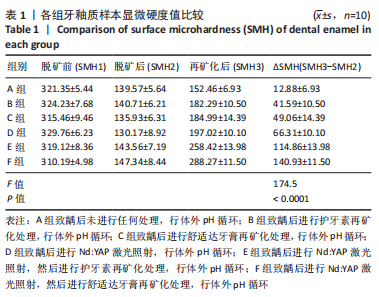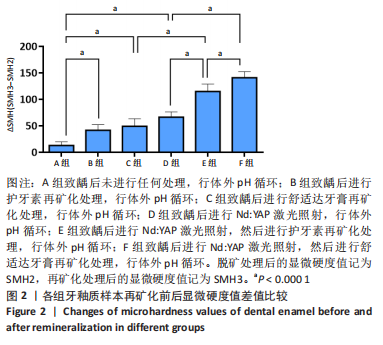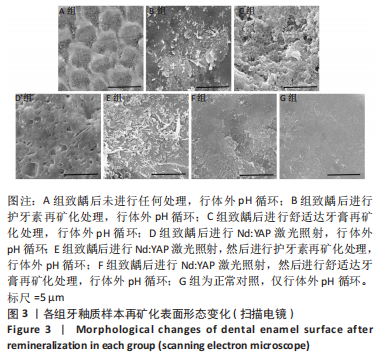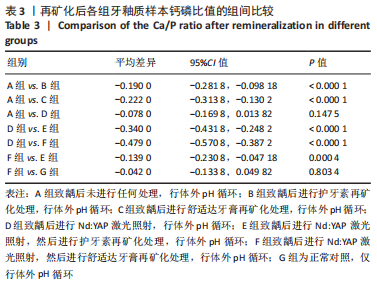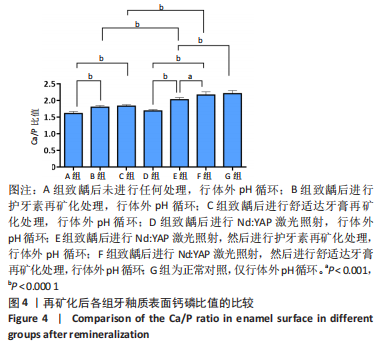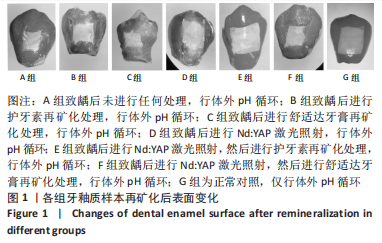中国组织工程研究 ›› 2024, Vol. 28 ›› Issue (3): 360-365.doi: 10.12307/2023.838
• 组织工程口腔材料 tissue-engineered oral materials • 上一篇 下一篇
掺钕钇铝钙钛晶体激光结合两种再矿化制剂与早期釉质龋的再矿化
许颖华1,2,刘 婧2,尤 权2,文志豪2,高 璐2
- 1上海市浦东新区眼病牙病防治所,上海市 200011;2大连医科大学口腔医学院,辽宁省大连市 116044
Effect of neodymium-doped:yttrium aluminum perovskite laser combined with two kinds of remineralizers on remineralization of early enamel caries
Xu Yinghua1, 2, Liu Jing2, You Quan2, Wen Zhihao2, Gao Lu2
- 1Pudong New Area Eye Disease and Dental Disease Prevention & Treatment Center, Shanghai 200011, China; 2School of Stomatology, Dalian Medical University, Dalian 116044, Liaoning Province, China
摘要:
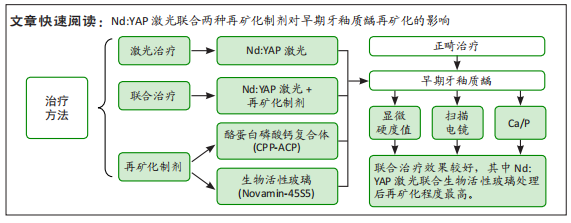
文题释义:
掺钕钇铝钙钛晶体激光:波长为1 340 nm,水吸收率为2.700 832,激光的性能比较稳定,输出能量较高;与其他激光比较,组织穿透深度比较浅,临床上各项操作比较安全。在口腔医学临床应用方面,掺钕钇铝钙钛晶体激光可用于牙本质敏感、根管消毒、根尖封闭及种植体周围炎等,具有广阔的口腔医学临床应用前景。早期牙釉质龋再矿化:牙体表面龋坏的发生和发展是一个动态变化的过程,主要表现为脱矿和再矿化的交替进行。早期牙釉质龋阶段在牙釉质表面脱矿形成白垩色斑块,此阶段如果采取相应治疗手段促进其再矿化可以抑制或者逆转龋病的进一步发展,这个过程称为早期牙釉质龋再矿化。
背景:近年来,多种激光被广泛应用于口腔医学相关的各种疾病,包括龋病的预防及治疗。
目的:探讨掺钕铝酸钇晶体(neodymium-doped: yttrium aluminum perovskite,Nd:YAP)激光联合两种再矿化制剂对早期釉质龋再矿化的作用。方法:将60颗牙釉质块体外建立人工龋模型后,随机分为6组(n=10):A组不进行任何处理,行体外pH循环;B组进行护牙素(主要成分为酪蛋白磷酸钙复合体)再矿化处理,行体外pH循环;C组进行舒适达牙膏(主要成分为生物活性玻璃)再矿化处理,行体外pH循环;D组进行Nd:YAP激光照射,行体外pH循环;E组进行Nd:YAP激光照射,然后进行护牙素再矿化处理,行体外pH循环;F组进行Nd:YAP激光照射,然后舒适达牙膏再矿化处理,行体外pH循环;再矿化处理2次/d,实验周期20 d。G 组为正常对照,未致龋,未进行再矿化处理,仅行体外pH循环。实验结束后,检测各组牙釉质表面的显微硬度、形貌与Ca/P比值。
结果与结论:①B、C、D组牙釉质表面的硬度值高于A组(P < 0.000 1),E、F组牙釉质表面的硬度值明显高于B、C、D组(P < 0.000 1),F组牙釉质表面的硬度值明显高于E组(P < 0.000 1);②扫描电镜下可见,A组牙釉质表面存在大量的脱矿孔隙;B组牙釉质表面有矿物质沉积,沉积不均匀且较为疏松;C组牙釉质表面有大量矿物质沉积,且钙化团块间可见脱矿孔隙;D组牙釉质表面较为平整,脱矿孔隙较A组明显变小,釉柱间质有破坏;E组牙釉质表面矿物质沉积较厚,脱矿孔隙明显减少;F组牙釉质表面沉积的矿化物最为致密且均匀,脱矿孔隙细小;③B、C组牙釉质表面Ca/P比值明显高于A组(P < 0.000 1),E组牙釉质表面Ca/P比值明显高于B、C、D组(P < 0.000 1),F组牙釉质表面Ca/P比值高于E组(P < 0.001);③结果显示,生物活性玻璃、酪蛋白磷酸钙复合体、Nd:YAP激光在牙釉质脱矿后均具有促进牙釉质表面再矿化的作用,Nd:YAP激光联合生物活性玻璃或酪蛋白磷酸钙复合体能进一步加强牙釉质龋的再矿化作用,其中Nd:YAP激光和生物活性玻璃的联合使用效果最佳。
https://orcid.org/0000-0003-0698-5245(许颖华)
中国组织工程研究杂志出版内容重点:生物材料;骨生物材料;口腔生物材料;纳米材料;缓释材料;材料相容性;组织工程
中图分类号:
